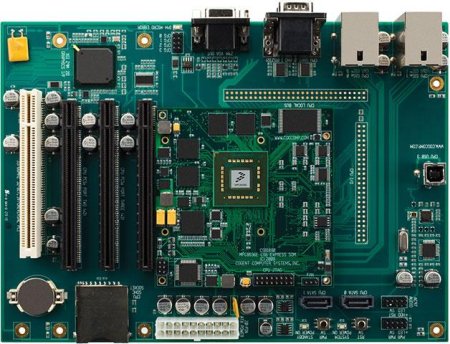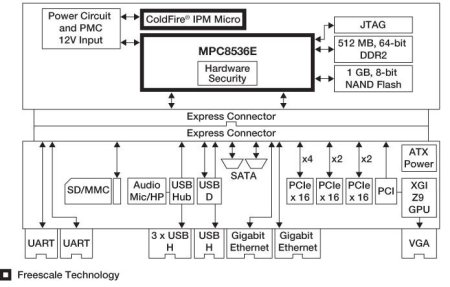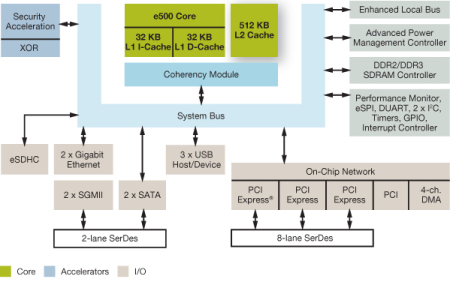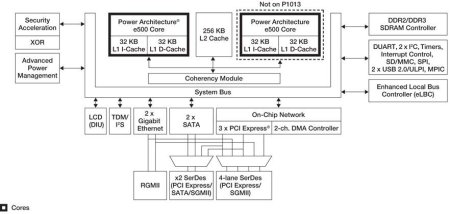Android ported to PowerPC
Oct 27, 2009 — by Eric Brown — from the LinuxDevices Archive — 56 viewsFreescale Semiconductor says it is now accepting orders for a hardware/software platform for developing Android applications on Power Architecture PowerQUICC and QorIQ processors. The initial MPC8536E-ADK Android platform, which combines an Android runtime developed by Mentor Graphics and a board based on the PowerQUICC III MPC8536E, appears to be the first Android port to the PowerPC.
When Mentor Graphics acquired Linux development firm Embedded Alley in late July, it announced plans to continue an existing Embedded Alley project to port Android to Freescale's Power Architecture ( PowerPC) based QorIQ and PowerQUICC III processors. The initial port, which Mentor promised would be for the Freescale MPC8536E (PowerQUICC III) and would be complemented by custom-tailored support, has now arrived. (See farther below for more on the MPC8536E and QorIQ processors.)
Mentor Graphics, best known for its Nucleus OS real-time operating system (RTOS), also announced it was working with ARM Ltd. and Marvell Semiconductor on separate projects that combine Linux and Nucleus OS on the same platforms. A month before being acquired, Embedded Alley announced the completion of its Android port to MIPS, in conjunction with MIPS and RMI. (More recently, Acer announced what appears to be the first Android port to the x86 platform with the Intel Atom-powered Aspire One AOD250-1613 netbook.)
According to Freescale, the initial MPC8536E-Android platform will target products for industrial, networking, storage, and media equipment markets. The company specifically mentions multifunction printers, industrial equipment, and touchscreen interfaces for system controls.
Answering skeptics who question whether Android is sufficient to handle devices beyond smartphones and other mobile consumer electronics equipment, or who wonder what advantages Android has over plain 'ol Linux in the broader embedded market, Freescale notes that "the highly flexible Android OS can be dynamically upgraded, thereby generating new revenue sources via networked services."

MPC8536E-ADK carrier board
(Click to enlarge)

MPC8536E-ADK block diagram
(Click to enlarge)
- Processor — 1.25GHz MPC8536E PowerQUICC III processor
- Memory — 512MB 64-bit DDR2-500 memory with ECC
- Flash — 512MB NAND flash
- Flash expansion — Bootable 4-bit SD/MMC Port (SDIO-compliant)
- Expansion — 3 x PCIe connectors; 32-bit 3.3V PCI edge connector
- Storage — 2 x SATA connectors
- Display — XGI Z9M 2D graphics controller with 8MB frame buffer
- Networking — 2 x 10/100/1000 Ethernet ports
- Other I/O:
- USB-B connector
- 4 x USB 2.0 host ports
- 2 x serial ports
- I2C port
- 8 x GPIO lines
- 4 x PCI interrupts
- Standard 16-pin JTAG
- Headphone and Mic interface
- Format — Flex/MicroATX
The MPC8536-ADK is preconfigured with an Android 1.5 runtime, the Dalvik virtual machine, and demonstration applications, enabling design engineers to evaluate Android bytecode operation on the MPC8536E, says Freescale. The platform also ships with source code, tool chain, and instructions to rebuild the Android run-time environment.
Specific MPC8536-ADK runtime features are said to include:
- Prebuilt Android runtime image
- Optimized Android Virtual Machine (Dalvik) e500v2 on MPC8536 processor (later P1022)
- Android Library (Bionic) support, optimized for e500v2
- Linux 2.6.28 patched and configured for Android OS
- Android OS version 1.5 (Cupcake)
- VGA graphics mode up to 1600 x 1200
- 2D graphics library, 3D graphics library based on OpenGL ES 1.0
- Ethernet connectivity
- Web browser, WebKit application framework
- Media support for H.263, H.264, MPEG-4 SP, AMR, AAC, MP3, WAV, JPEG, PNG, GIF, BMP
- USB mouse and keyboard
- Android applications demonstration
Freescale MPC8536 and QorIQ background
The MPC8536 processor was first previewed in 2008, and is billed by Freescale as a "highly integrated PowerQUICC III with advanced power management." The MPC8536e combines a PowerPC-based e500 processor core, clocked at up to 1.5GHz, with 32KB L1 cache, 512KB L2 cache, and a 64-/32-bit DDR2/DDR3 memory controller that supports up to 667MHz data rates. There is also a four-channel DMA controller.

MPC8536e block diagram
(Click to enlarge)
An Android development platform is also being readied for release in 2010 supporting Freescale's more powerful QorIQ system-on-chip (SoC). Considered a next-generation heir to the PowerQUICC III line for high-end networking and other demanding embedded applications, the QorIQ was announced in June 2008.
The QorIQ is said to be pin- and software-compatible with PowerQUICC, and is based on one to eight e500 cores clocked from 400MHz to 1.5GHz. The SoC is said to be fabricated with 45nm process technology, leading to greater claimed power efficiency.

QorIQ P1022 block diagram
(Click to enlarge)
The top-of-the-line eight-core P4080 version of the QorIQ began sampling in early September. The P4080 boasts a private backside cache per core, tri-level cache hierarchy, datapath acceleration, a Virtutech-based hypervisor, and a CoreNet "coherency fabric" inter-core interconnect.
In June of this year, Freescale itself announced a Linux-ready networking security stack for both its QorIQ and PowerQUICC processors called Vortiqa. The embedded software leverages the QorIQ's pattern matching engine, security accelerator, datapath acceleration, and other features, says Freescale.
Availability
The MPC8536E-Android platform for the PowerQUICC III MPC8536E is now available for pre-order from Freescale, and is expected to begin shipping in Q1 2010. Suggested resale pricing is said to be $995 in unit quantities. A development system for QorIQ processors is said to be due in 2010.
More information about the MPC8536-ADK may be found here.
Freescale and Mentor Graphics will debut the MPC8536-ADK during a one-hour webcast on Oct, 29 at 10AM Central time. The web seminar will cover topics such as accelerating Android application development. Registration and more information may be found here.
This article was originally published on LinuxDevices.com and has been donated to the open source community by QuinStreet Inc. Please visit LinuxToday.com for up-to-date news and articles about Linux and open source.